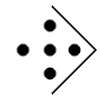Snakes and Ladders is a popular game for children all over the world, but there are some interesting facets of its origins that people who grew up playing it might not know. It's an important game, not only because of its worldwide popularity, but because it shares a similar style of game play with other highly influential games. Earlier, I described The Game of Goose, which originated in Europe toward the end of the Middle Ages and was played in America from Colonial times through the 19th century, in various forms. The Game of Goose is a race game, where players try to be the first to reach the end of a path. Some spaces on the path help players to move forward, while others can send them backward. This is basically how Snakes and Ladders is played, but Snakes and Ladders is played on a square board with a zig-zagging path, while The Game of Goose is played on a spiral path. The square board is important because, as I mentioned before, some scholars believe that the concept of the square game board might be an Indian invention (Botermans "World", p. 33). There are many games that are popular around the world that are played on square boards, most notably Chess, which was developed from the Indian game of Chaturanga. But, the comparisons don't end there, because there is another game well-known to modern children which involves a journey down a path where different spaces can either help or hurt players: The Game of Life. Modern Game of Life boards don't resemble Snakes and Ladders much because they feature winding paths, but the comparison between the games becomes more obvious when you see the square board for the original edition of the game from 1860, when it was called The Checkered Game of Life. (Get it? It was played on a board that looked like a Checker board and some people lead "checkered" lives, so it was the "Checkered" Game of Life. Ha, ha.) That leads us to what Snakes and Ladders is really about. It's about life. Or, depending on how you look at it, it's about lives.
.
Snakes and Ladders
The rules for this version of the game and the basic design of the board come from Play It Again by Asterie Baker Provenzo and Eugene F. Provenzo, Jr., pp. 20-23, with some further information from The Way to Play by the Diagram Group, pp. 16-17.
Players:
Object: To be the first to reach the end of the path.
Equipment: The board (printable), a pair of dice, small tokens or markers to use as playing pieces (one for each player, these can be any small objects that look different from each other, even small pieces of colored paper would work)
The Board: The path along the board is traditionally spiral-shaped with 63 spaces for the players to land on (although there are boards with different numbers of spaces). The game board I've created has a square shape because I'm still experimenting with the best designs for printing (traditional Goose game boards are more rounded), but it should still be played as a spiral, moving along the spaces as they are numbered. Some of the spaces are marked with special symbols which either help the player who lands on them or gives them a penalty (see section below).
Differing Boards: Some modern versions of the game call it Chutes and Ladders. This is how I first encountered the game as a child, and it makes sense because kids can easily understand the concept of going up a ladder and sliding down a chute, like a playground slide. I was confused when I was first told that the proper name for the game was Snakes and Ladders because I couldn't figure out why anybody would want to slide down a snake.
Again, old-fashioned Goose boards are usually more rounded than the ones I've created. I'm still experimenting with the best board shapes and sizes for printing, so the design I use here may change later to look more like the original Goose games.
Beginning: The players each roll the dice, and the person who rolls the highest becomes the first player.
Playing: The players take turns rolling the dice. They total the numbers on the dice and move that number of spaces down the path on the board, starting with space 1. Two players cannot occupy the same space at the same time, so if a player lands on a space that is already occupied, the player takes the piece that was already there and puts it on the space that the current player just came from.
Winning: The winner is the first player to reach the last space on the path. However, the player must land exactly on the final space. If a player rolls a number higher than than what he needs to land on the last space, he must move the number of extra spaces backwards after he hits the final square. In other words, the player moves as many spaces as he needs to in order to land on the final square and then immediately continues moving backward until he has used up the total amount of his roll (Diagram Group 17). (Ex. If he is on space 60 and rolls a total of 7 on the dice, he moves 3 spaces forward to space 63, then 4 spaces back up the path, finally landing on space 59, which is one space before where he started.) If the space where the player finally lands while moving backward happens to have a goose on it, he will have to move back up the path again as many spaces as it took for him to get from the final space to the goose. (In the example I just gave, the player would have to move back a further 4 spaces for landing on a goose on space 59.)

